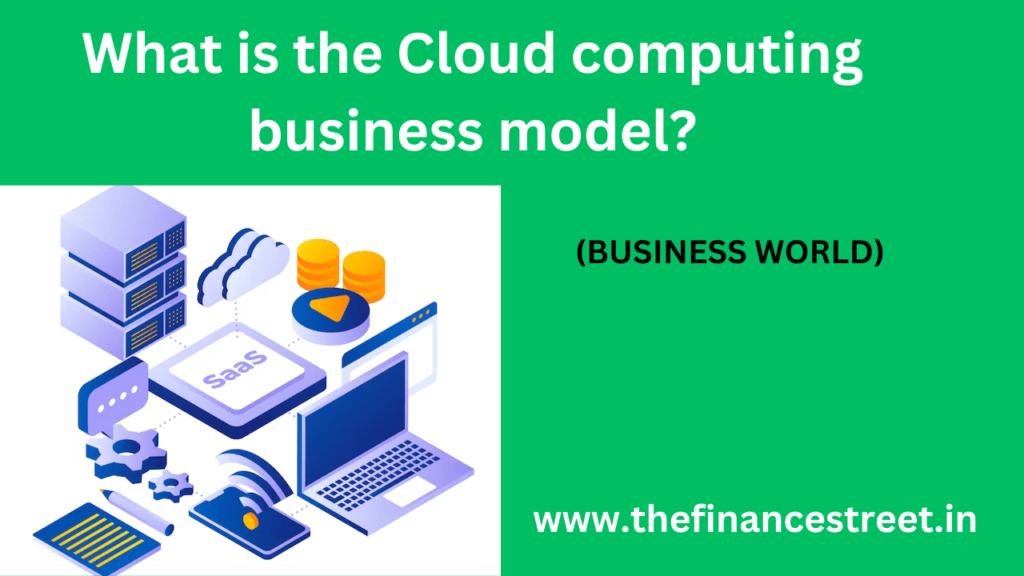Introduction-
The cloud computing business model has revolutionized the way organizations consume and manage IT resources, offering unprecedented flexibility, scalability, and efficiency. By leveraging cloud services, businesses can access a wide range of computing resources, including servers, storage, databases, and applications, over the internet on a pay-as-you-go basis. This model eliminates the need for upfront investments in hardware and infrastructure, enabling organizations to focus on their core business activities while leveraging the latest technologies and innovations.
Cloud computing has emerged as a game-changer for businesses of all sizes and industries, providing agility and responsiveness to rapidly changing market dynamics. With the ability to scale resources up or down dynamically based on demand, organizations can adapt quickly to evolving business requirements and seize new opportunities. Furthermore, the cloud computing business model fosters innovation by democratizing access to advanced technologies such as artificial intelligence, machine learning, and big data analytics, empowering businesses to drive digital transformation and achieve competitive advantages in the digital economy.
However, while the cloud computing business model offers compelling benefits, it also presents challenges and considerations that organizations must address. From data security and privacy concerns to vendor lock-in risks and compliance complexities, navigating the cloud landscape requires careful planning, governance, and risk management. Nevertheless, with the right strategies and best practices in place, organizations can harness the transformative power of cloud computing to accelerate growth, drive innovation, and achieve sustainable success in today’s fast-paced and interconnected world.
What is the Cloud computing business model?
The cloud computing business model revolves around providing access to computing resources, including servers, storage, databases, networking, software, and more, over the internet. This model enables organizations to leverage these resources without the need for investing in and maintaining physical infrastructure on-premises. Instead, they can rely on cloud service providers (CSPs) to deliver these resources on-demand, typically on a pay-as-you-go or subscription-based pricing model.
There are several key components to the cloud computing business model:
Service Models- Cloud service providers offer different service models to cater to varying needs and requirements:
Infrastructure as a Service (IaaS): Provides virtualized computing resources, such as virtual machines, storage, and networking infrastructure, allowing businesses to deploy and manage their applications and workloads.
Platform as a Service (PaaS)- Offers a platform for developing, deploying, and managing applications without the complexity of building and maintaining the underlying infrastructure. Developers can focus on writing code while the platform handles the rest.
Software as a Service (SaaS)- Delivers fully functional applications over the internet, eliminating the need for users to install, maintain, or update software locally. Examples include email services, customer relationship management (CRM) systems, and productivity suites.
Scalability and Elasticity- One of the primary advantages of the cloud computing model is its scalability and elasticity. Businesses can easily scale up or down their computing resources based on demand, allowing them to efficiently handle fluctuating workloads without overprovisioning or underutilizing resources.
Cost Efficiency- Cloud computing offers cost advantages by shifting from a capital expenditure (CapEx) model to an operational expenditure (OpEx) model. Organizations pay only for the resources they use, avoiding upfront investments in hardware, software, and infrastructure maintenance. Additionally, cloud services often offer economies of scale, reducing overall costs.
Flexibility and Agility- Cloud computing enables agility and flexibility in IT operations. Organizations can quickly provision resources, deploy applications, and adapt to changing business requirements without the constraints of physical infrastructure. This agility allows businesses to innovate faster and respond more effectively to market dynamics.
Security and Compliance- Cloud service providers invest heavily in security measures to protect data and infrastructure. They typically offer robust security features, including encryption, identity and access management, threat detection, and compliance certifications, helping organizations meet regulatory requirements and mitigate security risks.
Global Reach- Cloud computing allows businesses to access resources from data centers located worldwide, providing global reach and enabling them to serve customers in different regions efficiently. This global presence enhances performance, resilience, and availability while reducing latency for end-users.
In summary, the cloud computing business model revolutionizes the way organizations consume and manage IT resources, offering scalability, cost efficiency, flexibility, and security to drive innovation and accelerate digital transformation.
What are the important elements of Cloud computing business model?
The important elements of the cloud computing business model include:
Service Models- Cloud service providers offer various service models:
Infrastructure as a Service (IaaS)
Platform as a Service (PaaS)
Software as a Service (SaaS)
Scalability and Elasticity- Ability to scale resources up or down based on demand.
Cost Efficiency- Pay-as-you-go pricing model, reducing upfront investments and operational costs.
Flexibility and Agility: Rapid provisioning of resources and adaptability to changing business needs.
Security and Compliance: Robust security measures and compliance certifications to protect data and infrastructure.
Global Reach- Access to resources from data centers worldwide, enabling global operations and customer reach.
Innovation and Collaboration: Encouragement of innovation through access to cutting-edge technologies and collaboration tools.
Reliability and Availability- High availability and reliability of services through redundancy and failover mechanisms.
Managed Services- Offerings such as managed databases, analytics, and machine learning, allowing businesses to focus on core competencies.
Integration and Interoperability- Compatibility with existing systems and seamless integration with third-party services and applications.
These elements collectively contribute to the value proposition of cloud computing, empowering organizations to streamline operations, drive innovation, and achieve business objectives efficiently.
Why Amazon dominant player in the Cloud Computing Business?
Amazon is a dominant player in the cloud computing business due to several key factors:
Early Market Entry: Amazon Web Services (AWS) was one of the first major cloud service providers to enter the market, launching in 2006. This early entry allowed AWS to establish a strong foothold and gain significant market share before competitors entered the space.
Extensive Service Offering: AWS offers a comprehensive range of cloud services, including compute, storage, databases, networking, analytics, machine learning, and more. Its vast service portfolio caters to the diverse needs of businesses across industries, from startups to large enterprises.
Global Infrastructure: AWS operates a global network of data centers, providing widespread coverage and low-latency access to resources worldwide. Its extensive infrastructure footprint enables businesses to deploy applications and services closer to end-users, improving performance and reliability.
Scalability and Flexibility: AWS offers scalable and flexible solutions, allowing businesses to easily scale up or down their resources based on demand. This scalability is crucial for organizations with fluctuating workloads or rapid growth requirements.
Cost-Effective Pricing: AWS offers competitive pricing and a pay-as-you-go model, allowing businesses to pay only for the resources they use without upfront investments in hardware or infrastructure. Its pricing model and various pricing options, such as reserved instances and spot instances, provide cost savings and flexibility.
Innovation and Ecosystem: AWS continually innovates and introduces new services and features to meet evolving customer needs and industry trends. It fosters an extensive ecosystem of partners, developers, and third-party vendors, enabling collaboration and integration with a wide range of tools and technologies.
Security and Compliance: AWS prioritizes security and compliance, offering robust security features, data encryption, identity and access management, and compliance certifications. Its focus on security and regulatory compliance instills trust among customers, particularly in industries with strict compliance requirements.
Reliability and High Availability: AWS ensures high availability and reliability of its services through redundancy, fault tolerance, and disaster recovery mechanisms. Its global infrastructure and service-level agreements (SLAs) guarantee uptime and performance for mission-critical applications.
Overall, Amazon’s dominance in the cloud computing business can be attributed to its early market entry, extensive service offering, global infrastructure, scalability, cost-effectiveness, innovation, security, and reliability. These factors have positioned AWS as a leader in the cloud industry and a preferred choice for businesses seeking cloud solutions.
What is the importance of Cloud computing business model in India?
The importance of the cloud computing business model in India lies in its ability to drive digital transformation, foster innovation, and accelerate economic growth. Here are some key reasons why cloud computing is significant in India:
Scalability and Flexibility- Cloud computing allows Indian businesses to scale their IT infrastructure dynamically, enabling them to meet changing demands and scale up or down resources as needed. This flexibility is crucial for startups, small and medium-sized enterprises (SMEs), and large enterprises alike, allowing them to adapt to market dynamics and seize growth opportunities.
Cost Efficiency- Cloud computing offers cost advantages by eliminating the need for upfront investments in hardware, software, and infrastructure. Businesses in India can leverage the pay-as-you-go pricing model to lower operational costs, improve cost predictability, and optimize IT spending. This cost efficiency is particularly beneficial for resource-constrained startups and SMEs looking to compete effectively in the market.
Digital Inclusion- Cloud computing promotes digital inclusion by providing access to advanced technologies and IT resources to businesses across India, including those in remote and underserved areas. Cloud services enable businesses to overcome geographical limitations and access computing power, storage, and applications from anywhere with an internet connection, democratizing access to technology and leveling the playing field.
Innovation and Entrepreneurship- Cloud computing fuels innovation and entrepreneurship by democratizing access to cutting-edge technologies, such as artificial intelligence (AI), machine learning (ML), data analytics, and Internet of Things (IoT). Indian startups and innovators can leverage cloud platforms to develop and deploy innovative solutions rapidly, experiment with new ideas, and disrupt traditional industries.
Digital Governance and Citizen Services- Cloud computing plays a crucial role in enabling digital governance and delivering citizen services more efficiently and effectively. Government agencies in India can leverage cloud platforms to modernize IT infrastructure, enhance data security, and deliver digital services to citizens seamlessly. Cloud-based solutions enable governments to improve transparency, accountability, and service delivery across various sectors, including healthcare, education, and e-governance.
Global Competitiveness- Cloud computing enhances the global competitiveness of Indian businesses by providing access to scalable, flexible, and cost-effective IT infrastructure and services. Indian companies can leverage cloud platforms to expand their reach, enter new markets, and compete on a global scale. Cloud-based solutions empower businesses to innovate faster, deliver superior customer experiences, and drive growth in an increasingly competitive marketplace.
The cloud computing business model is of paramount importance in India as it enables businesses to embrace digital transformation, drive innovation, enhance competitiveness, and deliver value to customers and citizens alike. By leveraging cloud technologies, India can unlock new opportunities for economic growth, job creation, and social development in the digital age.
What are the key features of Cloud computing business model?
On-Demand Self-Service-Users can provision and manage computing resources, such as servers, storage, and applications, independently without requiring human intervention from the cloud service provider.
Scalability and Elasticity: Cloud services can scale up or down dynamically to accommodate changing workload demands. This allows businesses to adjust resource allocation in real-time, ensuring optimal performance and cost efficiency.
Resource Pooling- Cloud providers pool computing resources to serve multiple customers, allowing for greater efficiency and utilization of infrastructure. Resources are dynamically allocated based on demand, maximizing utilization and minimizing waste.
Broad Network Access- Cloud services are accessible over the internet from any device with an internet connection. This enables users to access computing resources and applications from anywhere, anytime, fostering mobility and flexibility.
Measured Service- Cloud computing services are typically metered, allowing users to pay only for the resources they consume. This pay-as-you-go pricing model provides cost transparency and enables organizations to align IT spending with actual usage.
Rapid Provisioning- Cloud services can be provisioned and deployed rapidly, often within minutes or hours, compared to traditional IT infrastructure, which may take weeks or months to procure and set up. This agility enables businesses to respond quickly to changing market conditions and customer needs.
Managed Services- Cloud providers offer managed services, such as databases, analytics, security, and monitoring, to offload operational tasks and simplify management for users. This allows organizations to focus on their core business activities while leveraging the expertise of the cloud provider.
Security and Compliance- Cloud providers implement robust security measures, including encryption, access controls, and compliance certifications, to protect data and infrastructure. They adhere to industry standards and regulations to ensure the security and privacy of customer data.
High Availability and Reliability- Cloud services are designed for high availability and reliability, with built-in redundancy, failover mechanisms, and data replication across multiple geographically dispersed data centers. This ensures business continuity and minimizes downtime.
Innovation and Integration- Cloud computing enables innovation through access to cutting-edge technologies, such as artificial intelligence, machine learning, and Internet of Things. Cloud services integrate with third-party tools and services, enabling seamless interoperability and ecosystem collaboration.
These key features collectively define the cloud computing business model, empowering organizations to leverage scalable, flexible, and cost-effective IT solutions to drive innovation, agility, and growth.
Critical Analysis of the Cloud computing business model-
While the cloud computing business model offers numerous benefits and opportunities, it also presents several challenges and considerations that warrant critical analysis.
Data Security and Privacy Concerns: One of the primary concerns associated with the cloud computing business model is data security and privacy. Storing sensitive data on third-party servers raises questions about data ownership, confidentiality, and protection against unauthorized access or breaches. Organizations must carefully evaluate the security measures implemented by cloud providers and assess the risks associated with data exposure.
Dependence on Service Providers: Cloud computing involves reliance on third-party service providers for critical IT infrastructure and services. While this outsourcing model offers scalability, flexibility, and cost savings, it also introduces dependencies and vulnerabilities. Organizations must consider the potential impact of service disruptions, downtime, or service provider failures on their operations and devise contingency plans to mitigate risks.
Vendor Lock-In: Adopting cloud services from a single provider may lead to vendor lock-in, where organizations become dependent on a specific vendor’s proprietary technologies, APIs, and services. This dependence limits flexibility and interoperability, making it challenging to switch providers or migrate workloads to alternative platforms. Organizations should evaluate vendor lock-in risks and adopt strategies to maintain flexibility and portability in their cloud deployments.
Compliance and Regulatory Challenges: Cloud computing introduces compliance and regulatory challenges related to data sovereignty, jurisdictional issues, and industry-specific regulations. Organizations operating in regulated industries must ensure compliance with data protection laws, privacy regulations, and industry standards when storing and processing sensitive data in the cloud. Achieving compliance requires collaboration between cloud providers and customers and may involve additional costs and complexities.
Cost Management and Optimization: While cloud computing offers cost advantages through its pay-as-you-go pricing model and resource optimization capabilities, managing and optimizing cloud costs can be challenging. Organizations must monitor usage, optimize resource allocation, and implement cost-saving strategies to avoid unexpected expenses and optimize their cloud spending. Failure to effectively manage cloud costs can lead to budget overruns and undermine the financial benefits of cloud adoption.
Performance and Latency Issues: Cloud computing introduces performance and latency considerations, especially for latency-sensitive applications and workloads. Accessing cloud resources over the internet may introduce network latency and performance variability, impacting application responsiveness and user experience. Organizations must assess performance requirements, consider geographic proximity to cloud data centers, and implement optimization techniques to mitigate latency issues and ensure optimal performance.
While the cloud computing business model offers compelling benefits in terms of scalability, flexibility, and cost efficiency, it also presents challenges related to data security, vendor lock-in, compliance, cost management, performance, and latency. Organizations must conduct thorough assessments, develop risk mitigation strategies, and implement robust governance and management practices to maximize the benefits of cloud computing while addressing its associated challenges effectively.
Conclusion-
In conclusion, the cloud computing business model represents a transformative paradigm shift in the IT industry, offering organizations unparalleled opportunities for scalability, flexibility, and cost efficiency. By leveraging cloud services, businesses can rapidly deploy and scale IT resources, innovate faster, and respond more effectively to changing market dynamics.
However, the cloud computing landscape is not without its challenges and considerations. Data security and privacy concerns, vendor lock-in risks, compliance complexities, cost management issues, and performance considerations necessitate careful analysis and strategic planning. Organizations must adopt a holistic approach to cloud adoption, balancing the benefits of agility and cost savings with the imperative of mitigating risks and ensuring compliance, security, and performance.
Despite these challenges, the cloud computing business model continues to evolve, driving digital transformation and empowering organizations to thrive in an increasingly interconnected and dynamic global economy.
In navigating the complexities of the cloud computing business model, organizations must prioritize transparency, accountability, and collaboration with cloud service providers. Effective governance frameworks, robust security measures, and comprehensive risk management strategies are essential for mitigating risks and ensuring compliance with regulatory requirements.
Additionally, organizations should invest in ongoing monitoring, optimization, and continuous improvement efforts to optimize cloud costs, enhance performance, and maintain agility in their cloud operations. By embracing a proactive and strategic approach to cloud computing, organizations can harness its transformative potential to drive innovation, improve operational efficiency, and achieve sustainable competitive advantages in the digital age.



